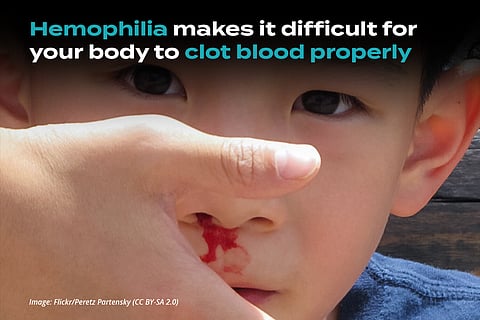Bridging the Gap - Health Equity for all
Hemophilia: When Your Blood Won’t Clot and You Can’t Stop Leaking
<p>We’ve all cut ourselves many times throughout life, but what if you couldn’t seal the gap and kept bleeding? Hemophilia is a rare genetic disorder that interferes with your body’s ability to clot blood properly. When these people are injured or receive a cut, even a minor one, the bleeding is prolonged.</p>
<p>Hemophilia is a lifelong condition but advancements in medical treatment mean we don’t need to cover these people in bubble wrap. Here’s a rundown of the condition.</p>
<h2>Hemophilia is a bloody mess</h2>
<h3>What causes hemophilia?</h3>
<p>Hemophilia is a condition in which your body is unable to make enough protein to help your blood form clots. Clotting factors are proteins in the blood that work with platelets to form clots and control bleeding. Low clotting factor levels increase the bleeding risk.</p>
<figure><img alt="" height="392" src="https://cdn.storymd.com/optimized/8okOgRi4o7/original.png" width="613" />
<figcaption>A woman suffering from hemophilia <em>Source: https://www.myupchar.com</em></figcaption>
</figure>
<p>The source of the leak is a mutation or change in one of the genes responsible for providing instructions to make clotting factor proteins. This mutation can stop the clotting protein from working properly or be missed altogether.</p>
<h3>Types of hemophilia</h3>
<p>There are three types of hemophilia, but the most common are Hemophilia A and B.</p>
<ul>
<li><strong>Hemophilia A.</strong><strong><strong> </strong></strong>The most common type (10 in 100,000 people). It is traced to an insufficiency with clotting factor 8.</li>
<li><strong>Hemophilia B. </strong>Occurs when you don’t have enough clotting factor 9. Affects roughly 3 in 100,000 people in the US. This is the type that Alexei had, and it’s also known as Christmas disease.</li>
<li><strong>Hemophilia C. </strong>This type contains a deficiency of factor 11 and is very rare (1 in 100,000 people). It is more common in certain ethnic groups, such as people of Ashkenazi Jewish descent. </li>
</ul>
<h3>Intensity of the flow</h3>
<p>Hemophilia’s severity is dependent on the level of clotting factors present in the patient’s blood. The symptoms may include:</p>
<ul>
<li><strong>Excessive bleeding</strong>. An injury or surgery can lead to continuous bleeding for a much longer time than usual. Patients may also experience spontaneous bleeding in joints and muscles.</li>
<li><strong>Bruising.</strong> Hemophiliacs bruise easily.</li>
<li><strong>Swelling</strong>. Bleeding in the joints and muscles can lead to pain and swelling, especially in the knees, elbows, and ankles.</li>
<li><strong>Blood in waste.</strong> If internal bleeding occurs in the gastrointestinal or urinary tract, patients may notice blood in their urine or stool.</li>
<li><strong>Nosebleeds.</strong> Nosebleeds are a common occurrence, especially for those with a severe case.</li>
</ul>
<h3>Diagnosis and treatment</h3>
<p>Blood tests can tell us the levels of clotting factors that are present in the blood. We can also conduct prenatal testing for families that have a history of the condition. There’s no cure for hemophilia and treatment focuses on preventing and controlling bleeding episodes.</p>
<p>Examples of treatments for hemophilia include:</p>
<ul>
<li><strong>Replacement therapy. </strong>This is the main treatment type for hemophilia. Clotting factor concentrates are infused into the bloodstream via dripping or injection. These infusions help to replace the missing or deficient clotting factor.</li>
<li><strong>Desmopressin (DDAVP).</strong> This is an artificial hormone to treat people with mild cases of hemophilia A. It is not used for hemophilia B or severe hemophilia A. DDAVP stimulates the release of stored clotting factors and increases the level of these proteins in the blood.</li>
<li><strong>Antifibrinolytic medicines. </strong>These drugs, which include tranexamic acid and epsilon aminocaproic acid, may be used alongside replacement therapy. They're typically delivered as a pill, and they prevent blood clots from breaking down. These drugs are most often used before dental work or to treat mild intestinal bleeding or bleeding in the nose or mouth.</li>
<li><strong>Gene therapy</strong>. An emerging treatment angle, gene therapy aims to correct the genetic mutation responsible for hemophilia, offering the potential for long-term relief. Gene therapy hasn’t yet developed to the point of being an accepted treatment, but researchers continue to test it in clinical trials.</li>
</ul>
<h3>Treatment of a specific bleeding site</h3>
<p>If there is pain or swelling in an affected joint, pain medicines, steroids, and physiotherapy may be used to counteract the problem.</p>
<h2>Life as a hemophiliac</h2>
<p>Living day to day with a body that doesn’t do well with bleeding requires extra care. A combo of medical treatment, lifestyle adjustments, and medical supervision will be needed. Keeping safe requires individuals with hemophilia to:</p>
<ul>
<li><strong>Avoid injury.</strong> Hemophilia doesn’t play well with risky sports and activities prone to injury. Contact sports like football, hockey, rugby, and wrestling are often too dangerous. Some people may be able to participate with proper protection, but this is limited.</li>
<li><strong>Exercise regularly.</strong><strong><strong> </strong></strong>Exercise from swimming, cycling, and walking builds muscles while protecting joints.</li>
<li><strong>Precautions are a fact of life.</strong> Where other people may see it as optional, protective gear for hemophiliacs is non-negotiable. Helmets and padding can make the difference between a serious bleeding episode or not.</li>
<li><strong>Access to rapid medical attention.</strong> Prompt treatment of bleeding episodes is essential to prevent complications like joint or organ damage. Whatever you’re getting up to, you shouldn’t be out of reach of emergency services in case something happens. </li>
<li><strong>Keeping up with treatment.</strong> Prescribed medication regimens need to be adhered to. The same goes for attending regular check-ups with healthcare providers for ongoing management of your hemophilia.</li>
</ul>
<h2>More on Hemophilia</h2><ul><li><a href="https://soulivity.storymd.com/journal/vm9nxlrugw-hemophilia" target="_blank">Hemophilia: Inheritance, Treatment, Living With</a></li><li><a href="https://soulivity.storymd.com/journal/4m8za9dtpm-hemophilia-a" target="_blank">Hemophilia A (Classic Hemophilia): Causes, Symptoms, Treatment</a></li><li><a href="https://soulivity.storymd.com/journal/dmqpoa9hew-bleeding-disorders" target="_blank">Bleeding Disorders: Types, Causes, Treatment</a></li></ul>


